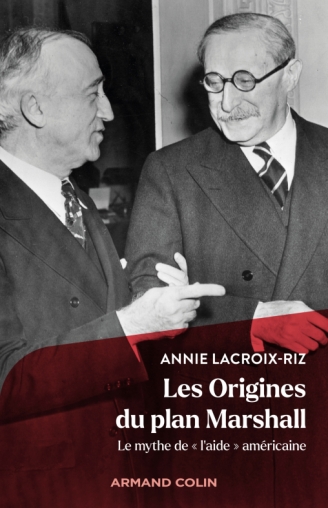Review: “Les Origines du plan Marshall”
Annie Lacroix-Riz analyses the “Myth of the US American Aid” to Europe following the Second World War and the path to the imposition of US hegemony.”
The Marshall Plan? That was, according to the belief widely held in the West, and semi-officially supported in West Germany, an unselfish reconstruction program by the United States after the Second World War. The program publicly presented on June 5, 1947, by George C. Marshall, US Secretary of State, at the time, was aimed at helping the economies of Europe – still floundering under the destruction of the war – to get back on their feet, while simultaneously “preventing the spread of communism.” This is how it is explained, for example, on the web portal “Lebendes Museum Online” (LeMo), which is sponsored by the German government’s Foundation ”Haus der Geschichte der Bundesrepublik Deutschland.” According to this, from 1948 to 1952, Washington, altruistically made enormous sums available, at the time, – around US $12.4 billion – in current values €157 billion – to improve living conditions in Western Europe. The Marshall Plan – a humanitarian miracle? Whoever is skeptical about this semi-official historiography, will find comprehensive background information in the recently published book by French historian, Annie Lacroix-Riz on “The Origins of the Marshall Plan” or, as described in the subtitle, “the Myth of the American Aid.”
Lacroix-Riz’s analysis, as meticulous as always, sheds light on the years 1941 to 1946 – the period, in which the United States imposed its “rise to global hegemony.” The French General Paul-André Doyen, head of the French delegation to the German Armistice Commission since September 6, 1940, had already predicted the German Reich’s demise back in July 1941: the United States, the actual victor of the First World War, would emerge from the Second even more powerful, while the European countries, which once could still have been its rival, would be seriously weakened. The world “would have to bow to the will of the United States over the coming decades.” Doyen was right.
During the period mentioned above, the United States laid the necessary groundwork – not only militarily, but above all economically. Important milestones, such as the Land-Lease-Act, which regulated – beginning in 1941 – the delivery of strategic combat material to allied countries, officially on a leasing basis; then the results of Bretton Woods in July 1944, which ensured the dominance of the US-dollar; and ultimately, particularly for France, the Blum-Byrnes Agreements of May 1946, compelling access for US cultural products, particularly films, to the French cultural market. All these milestones decisively contributed to paving the way for US-American products and capital into Europe. The Marshall Plan was merely the final cherry on the cake. It further increased sales of US products to West European countries, binding them even more closely to the USA, ultimately securing US hegemony.
Although Lacroix-Riz initially focuses on France, she provides numerous important insights into the all too often ignored prehistory of the West German-US American post-war relationships, stretching back to the period between the two world wars and tracing them even to the Second World War. It is true that Washington’s post-war policy was oriented toward establishing the closest possible ties to Western Europe on a broad scale. Therefore, about a quarter of the Marshall Plan’s funds went to Great Britain, a fifth to France, 11 percent to Italy, 8 percent to the tiny Netherlands and only 10 percent to the nascent Federal Republic of Germany. However, already during the war, Lacroix-Rix writes, US enterprises and financiers were able to ensure that important State Department plans, “were centered around Germany.” Lacroix-Rix cites numerous old transatlantic connections of that period – the Ford Group being merely the most prominent among them.
Those who read “Les origines du plan Marshall,” will acquire new insights into the backgrounds of old acquaintances, such as Carl Joachim Friedrich, who had made a name as the father of the so-called theory of totalitarianism, but who also trained functionaries for the US occupation authorities in Germany at Harvard University. Or of the Banker Kurt von Schröder, known in Germany, for having organized the fateful meeting with the future Reichs Chancellor Adolf Hitler on January 4, 1933 in Cologne-Lindenthal, but not necessarily for his transatlantic contacts. There are also revealing passages concerning personalities considered as the EU’s bedrock, such as Jean Monnet, who had helped to negotiate the Blum-Byrnes Agreements, a “model of ‘Atlanticist Elites,’” notes Lacroix -Rix.
With “Les origins du plan Marshall » Lecroix-Rix has presented another analysis, that reveals the deeper political and economic strata of Europe’s history of the 20th Century – such as her earlier works, including “Le choix de la défaite : les élites françaises dans les années 1930”; “L’intégration européenne de la France : La tutelle de l’Allemagne et des États-Unis“ or “Les élites françaises entre 1940 et 1944 : de la collaboration avec l’Allemagne à l’alliance américaine“. Anyone seeking to know which interests have formed the continent, making it what it is today, will find many answers in the in-depth analyses of this French historian.
Annie Lacroix-Riz: Les origines du plan Marshall. Le mythe de «l’aide» américaine. Armand Colin. Malakoff 2023. 576 Seiten. 29,90 Euro.
